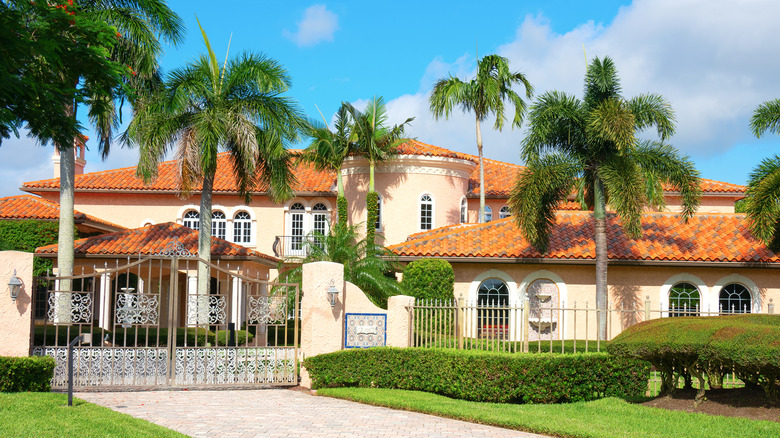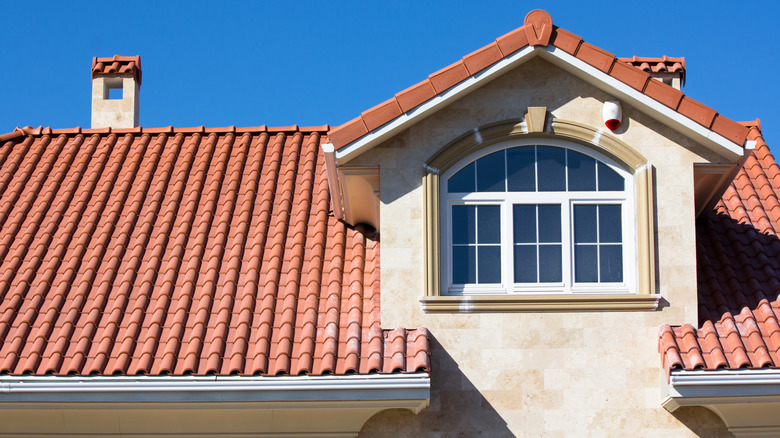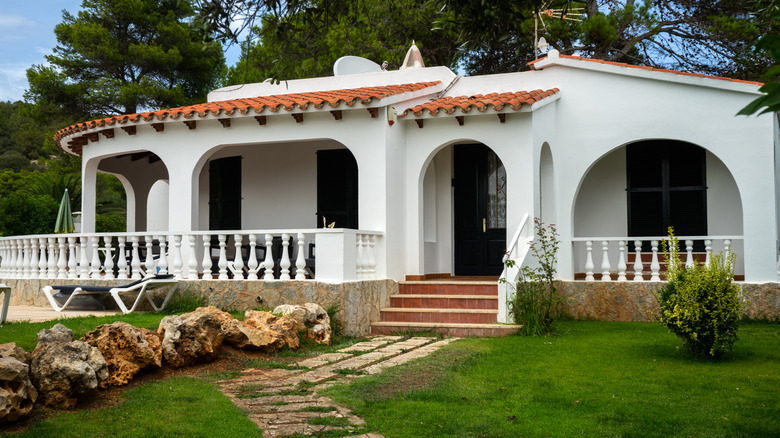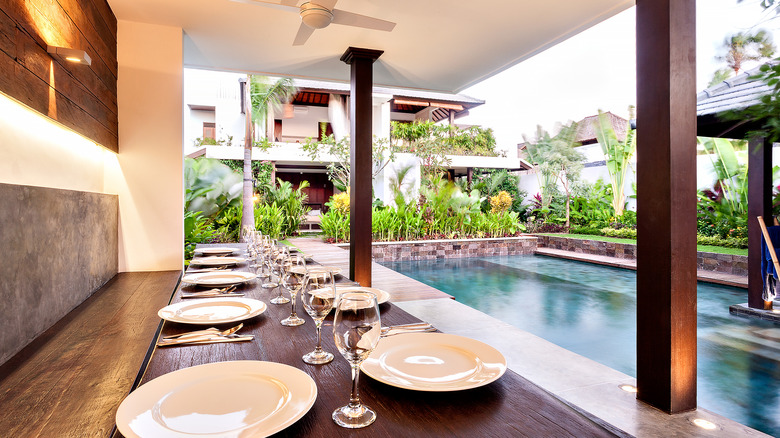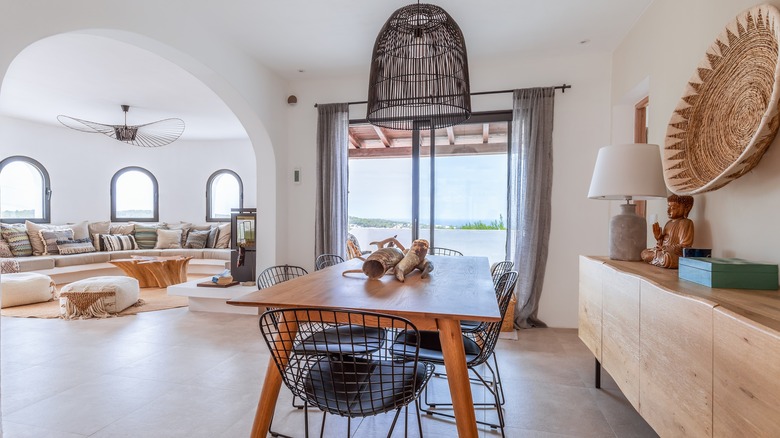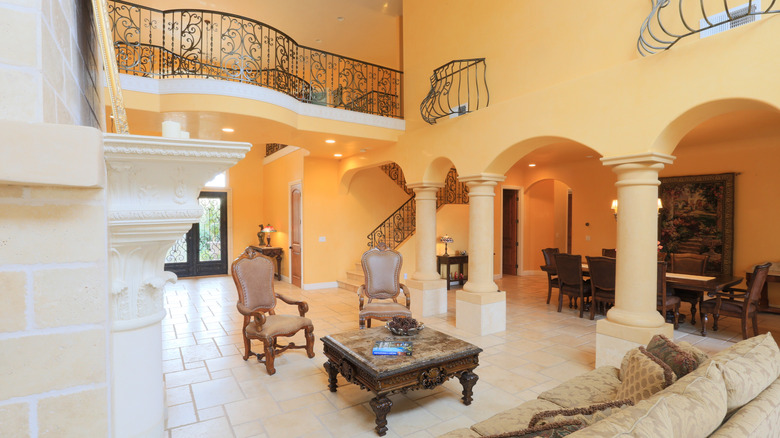What Details Do You Need To Make A Mediterranean Home?
Want to feel like you're on vacation every day? There are a few important details to know when establishing a Mediterranean-style home. Like a coastal villa, Mediterranean houses may encapsulate both an Italian and Spanish structure from the inside out. Originating from the Mediterranean Revival architectural panache of the boisterous 1920s, Mediterranean designs combine the nature of affluence amidst a laidback lifestyle (per Study.com). Often with one or two stories and an expansive frame, typical Mediterranean homes are diverse and are specifically suited to warmer, seaside climates like California or Florida.
What makes a home Mediterranean? According to Elle Décor, there are three main types — Italian Renaissance, Modern Mediterranean, and Spanish Revival. All three bring something different to its alluring and tranquil resort appearance. From columns and rounded archways to low-pitched roofs and airy floor plans, Mediterranean living typically combines an alfresco way of life with simple, rustic qualities. Inside and out, you might see various natural wood pieces and raw iron and stone features against bright white stucco walls. If you're building or renovating a Mediterranean-style home, read on to discover some of the most important elements to consider.
A red-tiled, low-pitched roof
Love that old-world terracotta look? One of the most distinctive characteristics of a Mediterranean house is its salient red, or terra cotta, roof tiles. Sometimes appearing like a reddish-brown color, terracotta clay shingles have been utilized for centuries as a topcoat for various structures, particularly originating from Asia, Europe, and Greece.
Traditional-looking red tiles are now available in a variety of materials, shapes, and sizes, notes Brava. Inspired by Spanish Revival architecture, modern Mediterranean styles continue to showcase authentic clay tiles for their durability and weather resistance, especially if the property is located near the sea.
Another distinguishable aspect of a Mediterranean-style roof is that it generally has a low slope, or is low-pitched, with wide overhangs. Some benefits of a low-pitched roof come from the simplified installation process as well as the maintenance. The overall presence of a low slope may cut costs on heating and cooling since there's less space in the attic or upper regions of your home, including a smaller expense required for materials and labor.
Smooth stucco façade
Clean and smooth, many Mediterranean houses feature a façade of stucco, as it's highly weather and fire-resistant while pleasing to the eye. This technique adds brilliance to the more dark, earthy aesthetics of the roof tiles, wood trim and doors, and hardware often present on the windows and balconies. Sometimes painted on brick, stucco is a fine layer of plaster that consists of Portland cement, lime, sand, and water.
Like clay roof shingles, stucco is also very resilient, cost-effective, and versatile. It is often painted brilliant white as seen pictured above, although you can mix other colors and textures to it like blue, pink, tan, or beige (per Improovy). For example, you might see a pastel pink in the many coastal towns of Florida or a sunny, yellowish hue in the southwest.
Additionally, incorporate a graceful, yet grand touch of detail with columns and/or pillars to coincide with the smooth aura of the stucco cladding. This opulent feature originates from the Palladian manner of Venetian architect Andrea Palladio, as it provides balance and a viewpoint to a domestic structure.
Alfresco living spaces
Why not continue the indoor elements out onto the patio? Many Mediterranean designs incorporate open floor plans and include modern, updated kitchens that are both pastoral and exquisite. Color choices often encompass a contrasting palette of brown and white or feature multi-color tiles, especially on floors and backsplashes. From this area, there may be several archways within the walls that lead to the outdoor elements upon a lanai, porch, or patio.
Indoor-outdoor living spaces are quintessential attributes for a Mediterranean home and open floor plan, which consistently includes a swimming pool and eclectic entertaining areas like the image shown above. A covered area with a grill may follow an open-air dining space with an umbrella, plus chaise lounges around the pool and spa areas. While outdoors, you might also integrate various plant life, trees, and flowers, particularly within a courtyard setting (via Landscaping Network). All this may resemble a pathway through Italy when you or the homeowners come and go through these picturesque spaces each day.
Archways within the structure
The arch is a common staple for a home with an Italian or Spanish flare. Like a rite of passage, you might see various shapes and sizes within the form of doorways, courtyard entryways, and windows, including balcony spaces. Arched windows provide an elegant demeanor within a living room as the appealing outline doesn't have to consume the entire structure, suggests Making Your Home Beautiful. The rounded outline offers a pleasing, feminine essence to saunter through, as it's ideal for the entrance to a home or corridor and can mingle with more square or other four-sided window shapes as well.
Ornamental yet modest, archways can also be seen within wood and stonework like a cellar door and its carved frame or a divider between living spaces as seen pictured above. This modern villa encapsulates a Mediterranean boho vibe by using white walls, a neutral palette, wood furniture and décor, and various arches. The three living room windows appear like petite portals to the outside elements of water, mountain hills, and a white-washed veranda.
Warm, decorative décor
Many Mediterranean-inspired homes feature a variety of decorative furnishings and decor, including natural stone elements, wrought iron railings, and hardwood furniture. Stone details are typically symbolic of a homestead's connection with nature, preferably amidst the sand and sea. Ornate carvings are often incorporated within flooring, fountains, doorways, fireplaces, and tiles, explains Stone News. Mediterranean-style homes are also characterized by the meticulous designs of iron metalwork seen on fences, railings, and stairways, especially on second-story balcony framing, which may add to the home's grandeur, as seen above.
Warm woods are also a huge must, especially on exposed wooden beams, paneling, window framing, or flooring. For a more modern approach, you might incorporate darker wood accents and furniture pieces like in a foyer armchair, accent table, or cabinet. Authentic types of wood to showcase might be walnut, pine, and olive wood, which reflects the nature of the Mediterranean. Additionally, a color scheme within a buoyant, seaside home may generally appear neutral and earthy with grays, white, browns, and beiges, with suggestions of color from yellows and reds to complement. To embrace a more vivid contrast, you might include an azure blue shade against a dramatic white backdrop for a sense of the Greek islands.
